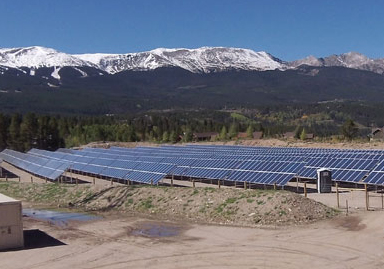SolarEnergy | January 22, 2014
When the clock ticked over to the year 2014, New Hampshire officially enabled residents to receive credit on their utility bills from solar energy — without a single solar panel placed on their roof.
Sound strange? A tweak in the state’s net metering laws has made it possible for apartment dwellers, renters, and business owners to buy their own solar panels (positioned as part of a larger array and located offsite) and receive credit for the generated energy. Known as virtual net metering, or community-owned solar, participants will get a credit on their bill if they consume less than their panels produce for the month.
New Hampshire is one of 11 entities — including California, Colorado, Connecticut, the District of Columbia, Illinois, Massachusetts, Maine, Minnesota, New Jersey, Rhode Island and Vermont — where some sort of virtual net metering policy is in place. In some places, such as California, restrictions limit eligibility. California State Sen. Lois Wolk is reintroducing a bill that would enable renting residents and business owners to be eligible alongside the building owners who can currently install solar PV and implement virtual net metering at affordable housing complexes.
“It’s not as attractive to investor-owned utilities that need to deliver returns,” said Paul Spencer, CEO and founder of Clean Energy Collective in Boulder, Colo., a company that is leading the way in setting up virtual net metering programs by negotiating deals with utilities and developing the solar projects needed to generate the energy.
Spencer’s company established the first such program in the U.S. in 2010 with Holy Cross Electric, a cooperative utility near El Jebel, a town outside Aspen. To reach that milestone, Clean Energy Collective had to wrestle with a number of challenges that had never been faced before, including satisfying security laws, federal tax laws, and developing software that enables participants’ energy credits to be directly applied directly to their utility bill.
Since then, Clean Energy Collective has brokered deals for virtual net metering with 14 other utilities in six states. At least one investor-owned utility — Xcel Energy — is part of the mix.
The key, Spencer said, is to negotiate a price for the energy that both the utilities and consumers can agree upon. And the utilities also benefit from the virtual net metering programs, he added, by helping them reach their state’s mandated renewable portfolio standard.
Expansion in Massachusetts
Recently, Clean Energy Collective announced plans to construct four solar arrays (in this context, also known as community solar gardens) in Massachusetts for virtual net metering programs. The solar gardens will be built in areas served by three of the state’s largest utilities.
In Massachusetts, as in other projects, the panels are available on a first-come, first-served basis. However, residents can only purchase solar panels with the capacity of generating 100 percent of their energy consumption.
Return on Investment?
With the average cost for a panel hovering around $750, and the first year’s return between 5.5 to 10 percent payback, Spencer estimates that buyers will break even anywhere from seven to 15 years on average, after taking inflation into account.
What happens if the owner of a solar panel has to move?
If one’s new home is located the same utility service area, the owner can just notify the utility. But if he or she is moving out of the area, it will have to be transferred to someone who lives in the area.
“It’s just like a car,” Spencer said. “You own it — so you can sell it for any price you want.”
Looking to the Future
As Clean Energy Collective currently has “active conversations” in play with over 135 utilities in 38 states, Spencer feels optimistic for the future growth of virtual net metering.
But he’s also realistic.
“All 50 states might be a challenge,” he says. “Some states are not a match for solar since there’s not a lot of sun, and the power prices are low.”
View the original story here.
Photo of community-solar array courtesy Clean Energy Collective
